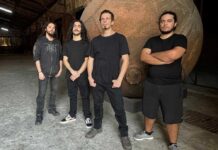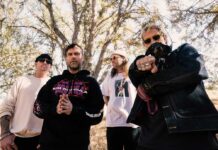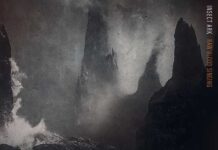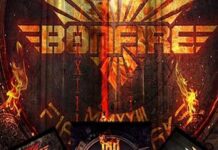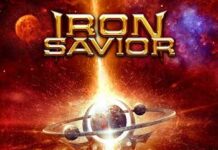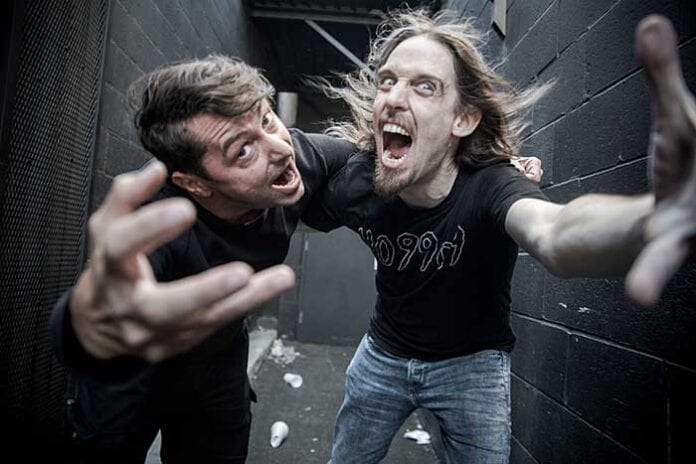
INTERVIEW WITH MITCH HARRIS BY SABY REYES-KULKARNI
PHOTOGRAPHS BY HANNAH VERBEUREN
The past year has presented its share of challenges, and it’s been difficult to avoid a mounting sense of dread. Whatever your circumstances might be, the best form of cold comfort has arrived with Scarcity, the debut album from longtime Napalm Death guitarist Mitch Harris and Megadeth/Cadaver/ex-Soilwork drummer Dirk Verbeuren’s new project Brave the Cold. If Prince once exhorted us to party as if the world was going to end, Scarcity allows us to imagine a grim future materializing into the present right before our very eyes.
Strangely, though, in what might best be described as an apocalyptic grindcore party record, Harris has crafted a zany and surprisingly fun prescription to the otherwise dystopian subject matter his chaotic music underscores. As Harris and Verbeuren zigzag between grindcore, death metal, hardcore, and unexpected flights into melodic metal à la Harris’ 2014 solo project Menace, one can picture the grind freaks of tomorrow banging heads and pumping fists alongside semi-human cyborgs and terminator AI bots under a foreboding sky. And even though Harris and Verbeuren threw everything and the kitchen sink into the mix, they didn’t waste a single note in coming up with an album that flows so seamlessly that it stands up to repeated listens.
As one of the giants of grindcore, Harris’ body of work spans seminal, genre defining releases with the likes of Napalm Death, Righteous Pigs, Defecation, and Meathook Seed. With Scarcity, he has finally staked out the middle ground. New song “Hallmark of Tyranny,” for example, recalls Bill Steer’s iconic riff from the Napalm Death classic “Unchallenged Hate,” while other tunes introduce new colors that have no precedent in his past work. Throughout, Harris assumes so many vocal guises, you might get the impression that there are several different people singing. Meanwhile, late stage production and a mix courtesy of ex-Machine Head/Soulfly guitarist Logan Mader (DevilDriver, Septicflesh, Cavalera Conspiracy) yielded a decidedly modern sheen. A most unique and spirited work of art, it’s easy to see what attracted the attention of Mission Two Entertainment, the new imprint launched by Victory Records founder Tony Brummel.
During a recent video call, Harris spoke with us about the making of Scarcity and offered his prescription for what it’s going to take for us to get through this turbulent moment in history.
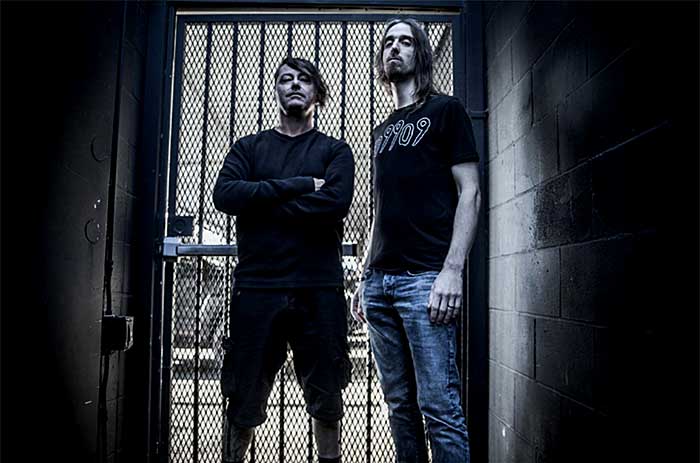
What’s been going on with you since 2015? You went on indefinite leave from Napalm Death right as the band was about to start touring behind the album Apex Predator – Easy Meat. It seemed like you’d be coming back, all this time went by and maybe that wasn’t going to happen, and then all of a sudden you are on the new Napalm album.
Yeah, it’s probably confusing for people. When I finished the Apex Predator album, we were touring endlessly, like 200 shows a year. My parents were based in Las Vegas, and I hadn’t even been back in three years. My dad had a lot of health problems, so I came back to scope it out. He needed double knee surgery, and in that process, they found out he had colon cancer. My parents always supported me, and the time came where I needed to take control of my schedule and prioritize family. I came back to help and relocated my own family, which was a massive step. I missed the first few tours and, in the end, I lost my dad. Then my mom was alone, but I was now here in Las Vegas with the kids. Compared to Birmingham, it was sketchy, and I wasn’t about to leave anyone to travel across the world. In that time, my mom was diagnosed with pancreatic cancer. So, over a period of three years, I lost my parents. I was home working on music, finding a new job, working on production and doing video walls and conventions to get by and establish us here in Vegas again. To be honest, I was a lot happier than constantly touring and never seeing family.
Music is still a key part of my life. My mom said, “I want you to do both albums—your Brave the Cold album and Napalm.” Of course, I wanted to do the Napalm album because they’re dear friends. We shared our lives together. The transition must have been tough for them as it was for me, watching from the sidelines while they’re playing with some of my favorite bands as a kid, like Slayer. To help Napalm with the transition, and as friends, I agreed to do the album. We couldn’t figure out a way forward with my new material. I have a vision for my material that doesn’t always align with everybody in Napalm’s tastes, or the way that the band works. And they had so many songs already that it was a no-brainer. I also felt I owed it to the community of Napalm supporters around the world, who were probably, “What happened to this guy? Where did he go?”
“LYRICS ARE IMPORTANT TO ME. I TRY TO MAINTAIN THE INTENSITY AND SEARCH DEEP FOR DIFFERENT VOCAL STYLES”
That was two years ago. I’d just done the Brave the Cold album with Dirk. We’d been writing to each other over email. I had 40 songs, “If you ever want to work together, check this out.” He chose 12 tracks, so I went to LA and we recorded drums. It was soon after my mom died, actually. Then I did the guitars and bass and was working on the vocals, and it was a good thing because it got me in shape for going over to Napalm. It’s not like I play three hours a day anymore, and the new Napalm album was so physically demanding. There’s some really hard stuff to play on it, with lots of dynamics. I got to see the band and hang out with Russ [Russell, producer] and Shane [Embury, Napalm Death bassist]. I was there for a week, and then I came back and finished the vocals for Scarcity.
Mission Two Entertainment finally caught wind of it, and I was glad to find a label that believed and saw potential in the music. I thought it was a perfect bridge between my previous work in Napalm, Defecation, even stuff like Meathook Seed, and a little bit of Menace. If there’s potential for any melody in the vocals, I’ll take it. Personally, I like albums that are unpredictable and get broken up style-wise. Lyrics are important to me. I try to maintain the intensity and search deep for different vocal styles that I hadn’t been known for in the past like the way I’m known for high screams in Napalm.
Right, that’s become your signature.
That vocal style wouldn’t carry for 45 minutes. To me, that would pretty much be annoying (laughs), so I try to break it up a bit. Some of these songs were written back in ’96, others around the time of Utilitarian [2012], and others are fresh and new. It was fun to focus my energy on lyrics and coming up with a consistent theme that aligns with my interests and what I research. I’ve heard complaints like, “The vocals are too clean. You can almost understand the words.” It’s like, “Well, that’s the point!” Of course, I love Napalm and what we’re known for, but it’s 2020. If we can’t offer something new and challenging, then what’s the point? That’s what makes it fun for me.
Going back to 2018, how did Scarcity come together with Dirk on the drums and Logan behind the boards?
As I was writing, I was, “What am I gonna do about a drummer?” Because that’s the most important part for any music. I’m really picky about who I work with. It’s not just about their degree of talent. It’s about how they are as people and their personality. I like fun, loving, happy, amazing people. Dirk ticks all those boxes. At one point, I was, “I could get this friend and that friend,” but then all of a sudden it turns into an album with 20 of my favorite friends and it gets overshadowed by who appeared on what. Shane was actually the one who brought him to my attention, like, “Dirk is awesome. He’s been working with me on this, that, and the other.”
“IT’S NOT AS EASY AS IT SOUNDS TO RECORD AND PRODUCE THIS KIND OF STUFF. IT TAKES A LOT OF EXPERIENCE, KNOW-HOW, AND UNDERSTANDING.”
I met Dirk, and he’s so friendly. He’s always been a Napalm fan and a fan of all the other Napalm related projects, the evolution of the Napalm institution as a whole, and every other kind of extreme music. It was perfect, really. When I sent him these songs, I wasn’t expecting much, but he was super excited about some of them. I found it odd, like, “That track? Really?” But it worked. He picked a nice, coherent flow of material. He wanted to use his own drum kit, and Vegas isn’t known for metal studios. It’s not as easy as it sounds to record and produce this kind of stuff. It takes a lot of experience, know-how, and understanding. He had his friend Adair [Daufembach], who has his own cool little setup in LA [Northwood Sound Studios]. We did the drums in four days. Then I was, “Okay, now I have to relearn these songs.” (laughs) I wanted to get my parts exactly right, because most of it was written spontaneously, and I have my own way of arranging songs.
Dirk was happy that I was willing to try the vocals myself. I thought about getting other people, but I did what I could. Logan wasn’t in the picture yet. I worked at a studio named Tone Factory, where I did guitar, bass, and some vocals. Hugo [Castillo, engineer] was great, and we did what we could mix-wise, but Hugo’s more experienced in other types of music. Then, when I saw Logan, I was, “Hey, apparently you do producing.” I heard Divine Heresy and some other things he had done. I had no idea how amazing he was. He’s done lots of stuff—Five Finger Death Punch, Gojira, etc. He has a new band named Once Human, which I also liked. I went to his house with the hard drives, he pulled it all into shape, we fixed a few things, and I finished the vocals there. He did a great job with the mix. It stands on its own as a different kind of production than Russ, who I’ve worked with a lot. I love what Russ did on the new Napalm and Menace and everything we’ve done in the past. He’s like the fifth Beatle, but Logan helped Scarcity feel complete.
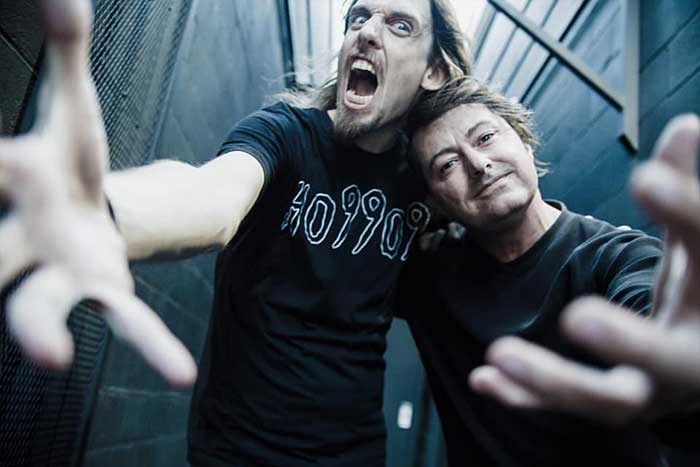
It’s interesting that the album’s flow stemmed from Dirk’s initial choice of songs. How much did you guys go back and forth on structure or arrangement?
I’ve worked with a few musicians in the past, and some things you either know or you don’t know. It doesn’t need to be said or explained. I play a little bit of drums myself, but it’s not like I would sit behind the drum kit and show him a part. If I have the time, I’ll map out songs with a drum machine to get across the basic idea. “Here’s a Discharge beat, here’s a blastbeat, the slow beat feels like this, here are the breaks.” I leave it simple and open for interpretation to where a drummer can add their own fills. I’m always open to different beats, but he just knew. There were times where he was going over a part and I’d be standing in the room going, “Yeah! Do this!” [motioning a drum fill].
“WE KEPT IT STRAIGHT AND TO THE POINT FOR THE ALBUM, BUT THERE ARE SOME MORE AVANT-GARDE TRACKS FOR THE EP.”
We were just laughing and having fun. I felt like a conductor at some points. Sometimes I’d be, “Okay, here’s a weird riff. Show me where the resolve is.” He’d go, “It’s right there,” and I’d be, “Dude!” I’d have to calculate the math on the drum machine, but Dirk just knows. We’d be sitting on the couch listening back, and the songs really had no direction. I knew what type of vocals and vocal patterns would fit, but for lyrics and titles, I’d be, “We need to call it something.” While they’d be saving the file, I’d go through my phone and be, “What about ‘Zero Longitude?’” He’d be, “Yeah!” We’re actually going to release an EP because we recorded 16 songs—over an hour’s worth of music. We kept it straight and to the point for the album, but there are some more avant-garde tracks for the EP.
The title track didn’t make the album, which I find interesting. That one was written in ‘96. It’s got a total Voivod approach, but I like the vibe of the album as a whole, the way the songs shape together. I find it rare these days that you can listen to an album from start to finish. This is one that you might make it to the end. Reign in Blood was like, what, 28 minutes? You don’t see that anymore. The first Righteous Pigs album was 14 minutes, and we put it out as a double gatefold—seven minutes a side. But it’s hard as a musician if you’re an artist and you’re into weird shit, because you want to fill the entire journey and let everyone absorb the whole body of work you’ve come up with. That’s too much for people sometimes. The label agreed that we should just make it face ripping, brutal hardcore deathgrind with a modern twist.
When you did the Menace album Impact Velocity in 2014, you used a term “AI.”
Audio installations. I’ve always wanted to do a visual album like Pink Floyd’s The Wall, where there’s an underlying storyline and the video fills the gaps and connects with the lyrics, but it’s not what you’d expect. I’m not all about live videos with stage diving where you’re just watching a band perform screaming their head off on stage. After a while, it’s, “Come on.” If there’s an artistic message there and you can achieve it, then great. I do a lot of video editing. There’s going to be at least six, maybe seven videos for this album. They’re done. They were done before we even signed with Mission Two. That actually helped them see the journey. A lot of what’s happening today is what the lyrics on the new album are about, and somehow I found some videos that actually told the story in a different way. I did the editing and then I contacted the directors and asked permission. We were talking about releasing a DVD that had videos running constantly from back to back. It’s not pretty at all. It’s quite disturbing, actually. But, to me, it suits the music. I’m very thankful that the directors actually agreed to it. [Harris gathered and edited video footage together and then approached the directors for permission to use their work in the band’s video.]
“IT’S NOT PRETTY AT ALL. IT’S QUITE DISTURBING, ACTUALLY. BUT, TO ME, IT SUITS THE MUSIC.”
Right, this is an extension of that whole concept.
I mean, if you’ve ever been to an art gallery, sometimes you’ll see something like a fake cow cut into 16 pieces. Or there’ll be music or some weird audio that tells a story and people are, “Whoooaaaa.” To me, it’s, “It’s just a cow” (laughs), but I get it. That’s art, and who can say what it is? To me, that’s what makes it fun.
You wrote these lyrics well before everything unfolded this year, but a lot of the keywords that jump out of the music line up with the moment.
It scared me a little bit. My approach is more like lyrical reverse psychology, “This is what’s going on. What are we going to do about it?” The message is that we’re all fucked, but we have to adapt and live with it. And then, as time dragged on and all this shit started happening, I’m listening back to the album at four in the morning and hearing, “Pan-de-mic o-men,” and, “Dys-to-pi-a,” and I’m, “Holy shit!” And I had the artwork before I was even done with the lyrics. The artwork is phenomenal. Santiago [Jaramillo] and Marco [Granja] at Triple Seis Design in Ecuador, they fuckin’ delivered in three days. I was, “This is the overlying concept,” but when the pandemic happened, they wrote to me and were, “Hey man, are you psychic or what!” Crazy. It also created a sense of urgency, like, “We need to get this out.” Because we need each other more than ever, and if there’s a time for unity, it’s now. I’m not talking about a revolution or a revolt. We need to come together and read through the fuckin’ lies of the media and stop letting it control our lives, but also somehow be diligent and get through this shit.




